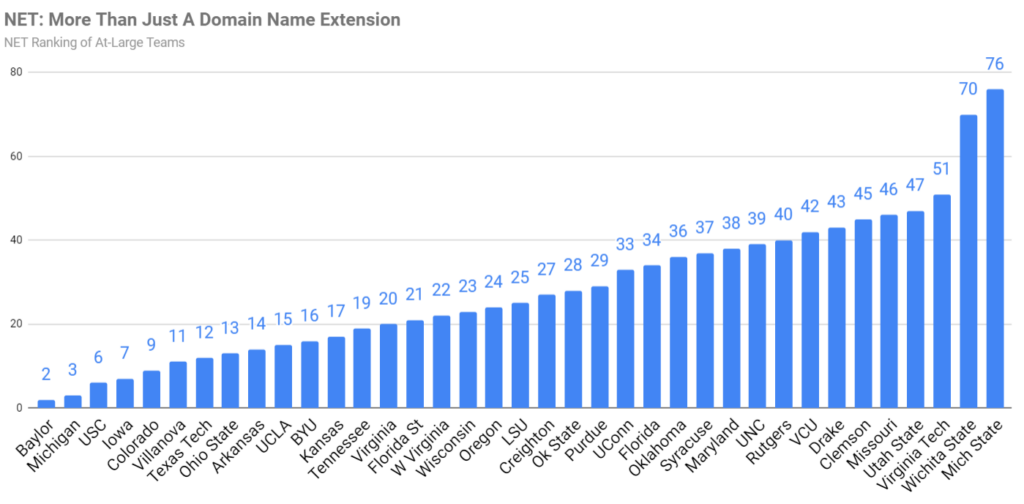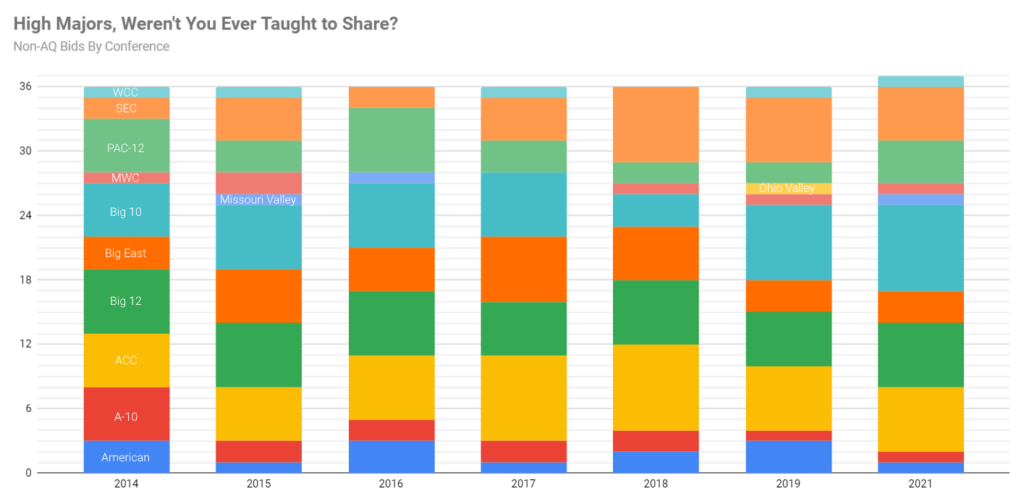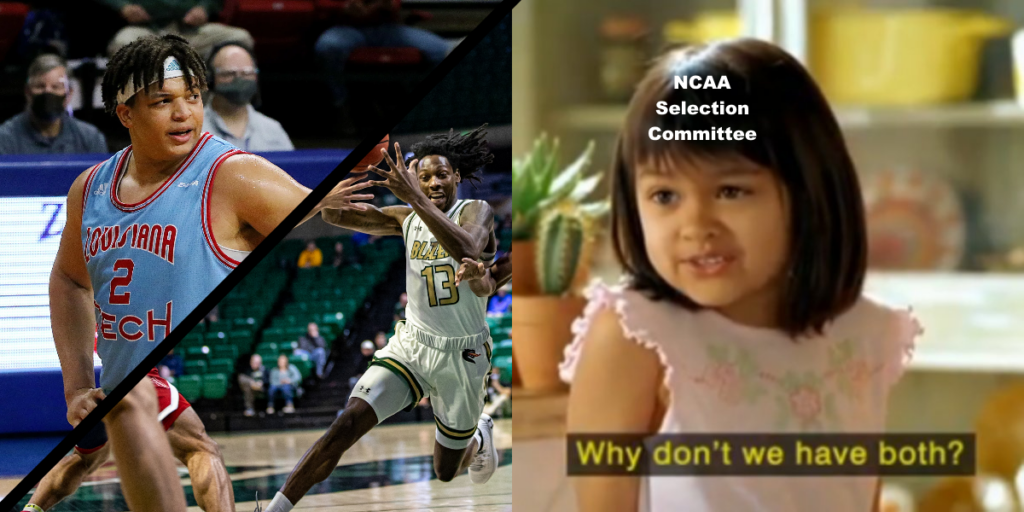To say that tomorrow’s home basketball game is a big deal is a bit of an understatement. For the first time since Tech shared a conference with Utah State in 2011, a team with a KenPom ranking of 43rd or better will be facing off against the Bulldogs in the Thomas Assembly Center.
And of course, the highly ranked team Tech will face off against is UAB.
The rivalry that kicked off with band chants and fistfights will have even more on the line as the Blazers head to the TAC. Conference USA, a perennial one-bid league since Memphis left the conference in 2012, finds itself within striking distance of its two-bid dreams.
In fact, just over a week ago, ESPN’s Joe Lunardi projected two C-USA teams (Tech and UAB) in his Bracketology prediction:
(ESPN updates their bracketology page every week, so now only one C-USA school is shown in the tournament. And they don’t keep a record of their earlier predictions for us to scrutinize because they are cowards.)
A lot has to go right here. A lot. But a two-bid C-USA is still possible, so let’s figure out what needs to be done to get that extra C-USA school into March Madness.
The first step of this process is pretty straightforward. The selection committee uses the NET rankings to help determine which teams get in and which don’t. NET stands for NCAA Evaluation Tool, and personally, I love any acronym that contains another acronym.
The word “help” is emphasized because the committee uses a lot more than just these rankings, but it’s a good place to start.
There are 68 teams that make the tournament, of which 32 are “auto-bid” teams. Those are schools that won their conference tournament. That leaves 36 at-large spots that a second C-USA team will try to compete for. So let’s take a look at those 36 at-larges from last year’s tournament:

Okay, looks easy enough right? Tech just needs to get a rank better than 76th, four spots up from the 81st NET ranking they currently possess.
But that “76th or better” philosophy doesn’t take into effect the “high-major” bias that most members of the selection committee have (or the fact that there are only 68 slots in the bracket). The committee will favor a team from the Big 10 (like Michigan State) and the American (like Wichita State) over a team from C-USA.
And that’s because conference prestige matters as well:
2021 NET Conference Ratings. Two-bid (or more) conferences in bold green, one-bid conferences in red
| Rank | Conference |
|---|---|
| 1 | Big Ten |
| 2 | SEC |
| 3 | Big 12 |
| 4 | Big East |
| 5 | ACC |
| 6 | Pac-12 |
| 7 | American |
| 8 | West Coast |
| 9 | Atlantic 10 |
| 10 | Southern |
| 11 | Missouri Valley |
| 12 | Mountain West |
| 13 | Patriot League |
| 14 | Conference USA |
| 15 | Mid-American |
| 16 | Colonial |
| 17 | Big West |
| 18 | Sun Belt |
(There was no reason to show this list all the way down to the #18 Sun Belt except for general pettiness.)
The American Athletic Conference was the 7th best basketball conference last year, but without the committee stretching to take Wichita State, they would have been a one-bid league for the first time in their (albeit short) history.
So if we’re going to look in the past for precedent, we need to focus on conferences like C-USA that don’t often put multiple teams into the March Madness tournament.
Unfortunately, not many of those conferences have been successful:

Looking at the seven years since the nasty Big East & American Athletic divorce, only two conferences match what we’re looking for. The Missouri Valley and Ohio Valley conferences have both been two-bid leagues at least once, but most years they were one-bid leagues.
This leaves us with three schools for comparison: 2015 Wichita State, 2016 Wichita State, and 2019 Belmont. What a… ahem… shocker, we’re going to talk about Wichita State again.
The 2015 Wichita State team ended with an RPI (precursor to NET) of 12, which is probably unattainable for any C-USA school this year. Luckily 2016 Wichita State had an RPI rank of 41 and 2019 Belmont had an RPI rank of 47.
Even if we expand to include the Mountain West and West Coast Conferences (which usually provide an at-large bid, but not always), we see similar RPI/NET rankings for teams that received at-large bids:
| Team | RPI/NET Ranking |
|---|---|
| Gonzaga (2019) | 2 |
| San Diego State (2014) | 13 |
| Nevada (2018) | 13 |
| BYU (2021) | 16 |
| St Mary’s (2017) | 17 |
| Nevada (2019) | 23 |
| San Diego State (2015) | 26 |
| BYU (2014) | 38 |
| Boise State (2015) | 43 |
| BYU (2014) | 44 |
| Utah State (2021) | 47 |
So that’s it, we have the worst possible NET ranking needed to be in consideration for an at-large bid as a Conference USA school: 47. A number that seems to make sense considering how close some of those Mike White Tech teams were to getting in as an at-large:

But we also can’t say that if you get a #47 rank, you get in. In fact, in that 2015 season where the Bulldogs were tantalizingly close to getting an at-large bid, the #47 team was a Miami (FL) team that also failed to reach the tournament.
We don’t even need to leave the conference to find another example. In 2018, Middle Tennessee didn’t get an at-large invite even with an RPI ranking of 27, close to the record of a #21 RPI ranking by Missouri State in 2006.
But as Tech fans, the most important question is: can Tech get down to a NET ranking of #47 before the end of the season? Currently ranked 81st, the Bulldogs may need quite a bit of help to jump 34 spots.
Fortunately, there are some conference opponents that can provide some assistance. North Texas is currently 57th and UAB’s NET ranking is #41. If Tech sweeps all four games against these two opponents AND gets to the final game of the championship tournament AND gets some outside help, I guess it’s possible. In the same way guessing a Wordle on the first try is possible.
UAB, meanwhile, is in a very good spot for an at-large. Although the ESPN bracketology currently lists them as one of the first four out, a win over the Bulldogs would put the Blazers back on that big board and in a much better position for Selection Sunday.
So if your goal is for a two-bid C-USA at all costs, you probably want to root for UAB to win this game and for the Blazers to eventually lose the tournament final.
But to hell with that. Dogs by 50.

